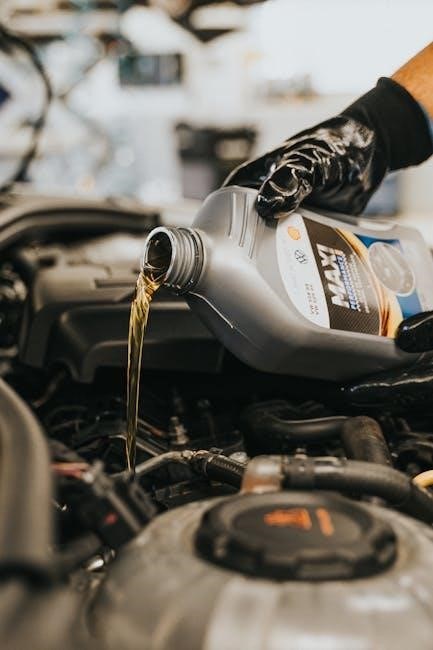Regular manual transmission fluid changes are crucial for maintaining smooth gear operation and preventing wear. This process involves draining old fluid and replacing it with fresh, high-quality lubricant to ensure optimal performance and longevity of the transmission system.
By following proper steps and using the right tools, you can perform this essential maintenance task effectively, ensuring your vehicle runs smoothly and avoiding costly repairs down the road.
Why Regular Fluid Changes Are Essential
Regular manual transmission fluid changes are vital for maintaining optimal performance and preventing premature wear. The fluid acts as a lubricant, reducing friction between moving parts and dissipating heat. Over time, the fluid degrades, losing its ability to protect components effectively. Old or contaminated fluid can lead to rough shifting, increased wear, and potential damage to gears and bearings. Regular changes ensure smooth operation, extend transmission lifespan, and prevent costly repairs.
Dirty or degraded fluid can also cause corrosion and reduce the transmission’s efficiency. Fresh, clean fluid ensures proper lubrication, preventing overheating and maintaining smooth gear engagement. Neglecting this maintenance can result in expensive repairs, making regular fluid changes a crucial part of vehicle care.
Overview of the Process and Benefits
A manual transmission fluid change involves draining the old fluid, inspecting the transmission pan, and refilling with new fluid. This process prevents wear, reduces friction, and ensures smooth gear shifts. Regular changes help maintain transmission health, prevent overheating, and extend the lifespan of internal components. Fresh fluid improves lubrication, enhances performance, and reduces the risk of costly repairs. This simple maintenance task is crucial for optimal vehicle operation and long-term reliability.
The benefits include improved shifting, reduced wear on gears and bearings, and better heat dissipation. Clean fluid ensures proper clutch engagement and prevents corrosion, making it a cost-effective way to protect your transmission and maintain your vehicle’s performance.

Understanding Manual Transmission Fluid
Manual transmission fluid is a lubricant designed to reduce friction, prevent wear, and enable smooth gear shifting. It plays a crucial role in maintaining transmission health and performance.
Types of Transmission Fluids Available
Various transmission fluids cater to different vehicle needs, including conventional, synthetic, and synthetic-blend options. Conventional fluids are cost-effective for standard transmissions, while synthetic fluids offer superior protection in extreme temperatures and high-stress conditions. Additionally, some vehicles require specialized fluids, like manual transmission specific (MTS) or gear oils. It’s essential to choose the fluid recommended by your vehicle’s manufacturer to ensure compatibility and optimal performance.
How to Choose the Right Fluid for Your Vehicle
Always consult your vehicle’s owner’s manual to determine the recommended transmission fluid type. Manual transmissions often require specific fluids designed for manual gearboxes, while automatics use different formulations. Consider factors like vehicle age, mileage, and climate conditions. Synthetic fluids are ideal for high-performance or extreme temperatures, whereas conventional fluids suffice for standard use. Ensure compatibility by checking the manufacturer’s specifications to maintain optimal performance and prevent damage.

Gathering Tools and Materials
To perform a manual transmission fluid change, you’ll need a drain pan, socket wrench, gloves, safety goggles, rags, a funnel, and the correct type of new transmission fluid. Jack stands and a torque wrench may also be necessary for safely lifting and securing the vehicle, as well as tightening the drain plug properly. Ensure you have all these tools and materials ready before starting the process to avoid delays or complications.
Essential Tools Needed for the Job
A socket wrench, drain pan, gloves, and safety goggles are indispensable for a manual transmission fluid change. A funnel ensures clean fluid transfer, while jack stands and a torque wrench provide stability and precise tightening. Rags help manage spills and wipe surfaces clean. These tools are crucial for a safe and efficient process, ensuring no leaks or damage occur during the fluid replacement.
Materials Required for a Successful Fluid Change
The essential materials include new transmission fluid, a drain pan, a replacement filter, and a new gasket or seal for the drain plug. Additionally, a torque specification chart, cleaning supplies like rags, and fresh lubricant for the drain plug are necessary. Ensure the fluid meets your vehicle’s specifications for optimal performance. Having all materials ready streamlines the process and prevents delays or damage during the fluid change.
Preparing Your Vehicle
Ensure the vehicle is warmed up and parked on level ground for accurate fluid drainage and access to the transmission pan.
Warming Up the Engine and Transmission
Warming up the engine and transmission is crucial before changing the fluid. Drive the vehicle for 5-10 minutes to circulate the transmission fluid, ensuring it reaches operating temperature. This thins the fluid for easier drainage and ensures all internal components are properly lubricated. However, avoid overheating the engine, as excessive heat can damage the transmission. A warmed-up system allows for a more efficient and complete fluid change.
Ensuring the Vehicle is on Level Ground
Ensuring the vehicle is on level ground is critical for a successful manual transmission fluid change. This ensures the fluid drains evenly and completely from the transmission pan. Use a carpenter’s level to verify the surface or position the vehicle on a lift or jack stands to achieve proper leveling. An uneven surface can lead to incomplete drainage, leaving old fluid behind and reducing the effectiveness of the fluid change. Proper leveling guarantees accurate fluid measurement and a clean swap.

Draining the Old Transmission Fluid
Draining old transmission fluid involves locating the drain plug, typically at the bottom of the transmission pan. Use a socket wrench to remove the plug, allowing the fluid to flow into a drain pan. Be prepared for the fluid to drain quickly and ensure proper disposal of the used fluid to protect the environment.
Locating the Transmission Pan and Drain Plug
To begin draining the fluid, locate the transmission pan, usually found at the bottom of the transmission. The drain plug is typically positioned at the lowest point of the pan. Use a wrench or socket to remove it. Ensure the vehicle is securely lifted on jack stands for safe access. Be cautious, as the fluid may drain quickly once the plug is removed. Always use protective gear and a drain pan to catch the fluid efficiently.
Safe Practices for Draining Fluid
Always wear protective gloves and goggles when draining transmission fluid. Use a drain pan to catch the fluid and prevent spills. Ensure the vehicle is securely lifted on jack stands to avoid accidents. Be prepared for the fluid to drain quickly once the plug is removed. Never drain fluid near open flames or sparks. Properly dispose of the used fluid and filter at an authorized recycling center to protect the environment. Follow all safety guidelines to avoid injury and contamination.

Refilling with New Transmission Fluid
Use the correct type of transmission fluid specified in your vehicle’s manual. Pour the fluid slowly using a funnel to avoid spills; Ensure the vehicle is level and the fill plug is tightly replaced after refilling. Check for leaks and test the transmission operation to confirm proper function and fluid level.
Removing the Fill Plug and Adding New Fluid
Locate the fill plug on the transmission and remove it using a socket wrench. Be prepared to collect any residual fluid that may spill out. Use a clean funnel to pour in the new transmission fluid, ensuring it reaches the recommended level specified in your vehicle’s manual. Avoid overfilling, as this can damage the transmission. Replace the fill plug securely and check for any signs of leakage. Start the engine and test the transmission to ensure smooth operation and proper fluid circulation.
Replacing the Fill Plug and Checking for Leaks
Tighten the fill plug securely using a torque wrench to the manufacturer’s specifications. Inspect the area around the plug for any signs of leakage. Start the engine and let it run for a few minutes, then shift through the gears to circulate the new fluid. Turn off the engine and check again for leaks. Ensuring the fill plug is properly sealed is critical to maintaining the transmission’s performance and preventing fluid loss.
Post-Fluid Change Checks and Maintenance
After refilling, check for leaks around the fill plug and drain pan. Test drive the vehicle to ensure smooth gear shifting and proper transmission function. Monitor fluid levels regularly to maintain optimal performance and prevent damage.
Inspecting for Leaks and Testing the Transmission
After refilling the fluid, inspect the transmission pan, drain plug, and fill plug for any signs of leaks. Check for puddles or stains under the vehicle. Take the car for a test drive, shifting through all gears smoothly to ensure proper engagement and no unusual noises. Pay attention to any slipping or hesitation, which could indicate issues. Finally, recheck the fluid level and consistency to confirm everything is functioning correctly.
Addressing any leaks promptly and verifying transmission performance ensures the fluid change was successful and maintains the vehicle’s reliability and performance over time.
Proper Disposal of Used Fluid and Filters
Used transmission fluid and filters are considered hazardous waste and must be disposed of responsibly. Take them to a recycling center or an auto parts store that accepts automotive fluids and components. Never dispose of these materials in the trash or down drains, as they can harm the environment.
Always check local regulations for specific guidelines on hazardous waste disposal in your area. Proper disposal ensures environmental protection and compliance with local laws, helping to maintain a cleaner planet for future generations.
Regular manual transmission fluid changes ensure smooth performance and longevity. Always follow manufacturer recommendations and maintain proper disposal practices for used fluids to protect the environment.
Importance of Regular Fluid Checks
Regular fluid checks are vital for maintaining transmission health. Low or degraded fluid can cause overheating, gear damage, and costly repairs. Always use a dipstick to monitor fluid levels and condition, ensuring it matches the manufacturer’s recommendations. Clean, translucent fluid indicates good health, while dark or gritty fluid signals a need for change. Regular checks prevent premature wear, reduce repair costs, and ensure smooth, reliable transmission performance. Neglecting fluid maintenance can lead to severe damage, emphasizing the importance of consistent monitoring and timely action.
When to Schedule the Next Fluid Change
Scheduling the next fluid change is essential for maintaining transmission health. Typically, manual transmissions require fluid replacement every 30,000 to 60,000 miles, depending on the vehicle and driving conditions. Check your owner’s manual for specific recommendations. Signs like slipping gears, grinding noises, or dark fluid indicate the need for a change. Regularly inspecting fluid levels and condition ensures optimal performance. Neglecting timely fluid changes can lead to costly damage, such as worn gears or synchronizers, emphasizing the importance of adhering to a consistent maintenance schedule.
